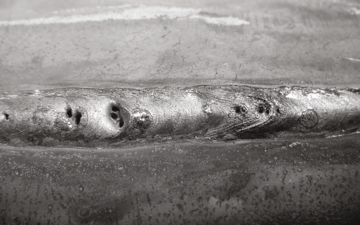Recognizing Porosity in Welding: Exploring Causes, Impacts, and Prevention Strategies
As professionals in the welding market are well conscious, understanding the reasons, effects, and avoidance strategies associated to porosity is vital for attaining durable and trustworthy welds. By diving into the origin triggers of porosity, examining its damaging effects on weld quality, and checking out reliable avoidance strategies, welders can improve their understanding and abilities to create top quality welds continually.
Typical Causes of Porosity
Porosity in welding is mostly triggered by a mix of factors such as contamination, incorrect shielding, and insufficient gas protection throughout the welding procedure. Contamination, in the form of dirt, grease, or corrosion on the welding surface, creates gas pockets when heated up, bring about porosity in the weld. Improper protecting happens when the shielding gas, commonly made use of in processes like MIG and TIG welding, is incapable to completely safeguard the liquified weld swimming pool from responding with the bordering air, causing gas entrapment and succeeding porosity. Furthermore, poor gas protection, often as a result of wrong flow prices or nozzle positioning, can leave components of the weld unsafe, allowing porosity to develop. These aspects collectively add to the formation of spaces within the weld, deteriorating its honesty and possibly creating structural issues. Recognizing and attending to these common causes are critical action in protecting against porosity and guaranteeing the top quality and stamina of bonded joints.
Results on Weld High Quality
The visibility of porosity in a weld can significantly compromise the general top quality and stability of the bonded joint. Porosity within a weld produces voids or tooth cavities that deteriorate the framework, making it extra susceptible to fracturing, deterioration, and mechanical failing.
Moreover, porosity can prevent the performance of non-destructive screening (NDT) strategies, making it testing to detect other defects or suspensions within the weld. This can bring about considerable safety issues, particularly in important applications where the architectural honesty of the bonded elements is paramount.

Prevention Techniques Introduction
Given the harmful influence of porosity on weld quality, effective avoidance techniques are essential to preserving the structural integrity of welded joints. Additionally, selecting the suitable welding parameters, such as voltage, current, and travel speed, can help minimize the risk of porosity development. By incorporating these avoidance strategies right into welding techniques, the event of porosity can be dramatically lowered, leading read here to more powerful and extra reputable bonded joints.
Value of Correct Protecting
Correct shielding in welding plays a pop over here critical function in preventing climatic contamination and making sure the stability of welded joints. Shielding gases, such as argon, helium, or a blend of both, are commonly utilized to safeguard the weld swimming pool from reacting with elements airborne like oxygen and nitrogen. When these responsive elements enter contact with the hot weld pool, they can cause porosity, causing weak welds with minimized mechanical residential or commercial properties.

Inadequate shielding can result in different defects like porosity, spatter, and oxidation, jeopardizing the structural integrity of the bonded joint. Therefore, sticking to correct protecting techniques is vital to generate top quality welds with very little flaws and guarantee the durability and dependability of the welded elements (What is Porosity).
Tracking and Control Approaches
Exactly how can welders properly keep track of and regulate the welding procedure to guarantee ideal outcomes and stop defects like porosity? By constantly keeping track of these variables, welders can identify discrepancies from the optimal problems and make prompt changes to protect against porosity formation.

Furthermore, carrying out proper training programs for welders is vital for keeping an eye on and managing the welding procedure successfully. What is Porosity. Informing welders on the relevance of preserving consistent specifications, such as proper gas shielding and travel rate, can assist protect against porosity issues. Routine evaluations and certifications can also make certain that welders excel in tracking and Related Site regulating welding processes
Furthermore, the usage of automated welding systems can boost tracking and control abilities. These systems can exactly manage welding parameters, reducing the possibility of human mistake and making certain regular weld quality. By integrating sophisticated surveillance innovations, training programs, and automated systems, welders can successfully monitor and manage the welding procedure to decrease porosity flaws and attain top quality welds.
Final Thought
